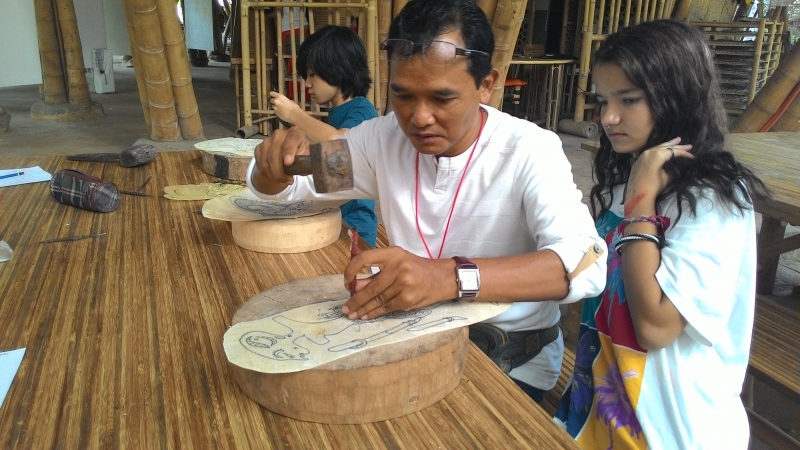”This is my culture and I want to learn more about where I am from… Ini budaya saya dan saya mau tahu lebih banyak tentang Bali”
– Made Kosala (Year 9)
By GS Art Teacher, Jen Buchanan
One way that Green School is developing its Kul Kul Connection with local communities is through our Visual Arts curriculum. The arts have a special place in relation to culture. Artistic expression and creativity are powerful ways in which we develop our cultural identities. People have always come together to sing, dance and express themselves through the arts. These shared rituals and creativity are at the heart of a strong community identity.
At Green School, the Visual Arts Curriculum is very much influenced by the school’s geographical location and the very rich cultural and artistic features that characterise Bali. With this in mind, this year the Visual Arts curriculum has introduced “Kesenian Indonesia” (Art of Indonesia) classes for students.

“Kesenian Indonesia” classes provide educational opportunities for our students to work with local artists in ways that promote environmental and cultural sustainability.
So what exactly does ‘Cultural sustainability’ mean?
It is a relatively new term, not easily defined.
‘Culture’ means many things to many people. Here we use it in the broadest sense to mean ‘our values, aspirations, traditions and shared memories. It also encompasses the way of life that is produced by how we develop, receive and transmit these processes’.
‘Sustainability’ can be defined as ‘meeting the needs of the present without compromising the needs of future generations’. Put these ideas together and you have
cultural sustainability – ‘developing, renewing and maintaining human cultures that create positive, enduring relationships with other peoples and the natural world’.
In the words of Nelson Mandela,”Like truth, culture and creativity are enduring.”

Most people think of the environment when they hear the word ‘sustainability’ – and looking after our precious earth is certainly important. However, social, cultural and economic sustainability are equally important. Together the four areas make up what is described as the ‘the Four Pillars of Sustainability’.
In the first High School module, “Lurking in the darkness – Shadow Puppets”, students work with Pak Wayang to learn the craft of traditional puppet making for the shadow theatre play, Wayang Kulit. Pak Wayang is a Dalang from Singapudu, Banjar Kebon.

Dalangs are master puppeteers who train for years to learn the art of shadow theatre. They are also spiritual leaders of their communities. The duties of a Dalang are intricate and are considered vital to ensuring the protection and well-being of society. Pak Wayang begun learning his craft at the age of 7, studying alongside his grandfather. These days he travels the world, teaching his craft at festivals in Spain, China, Iran and Tibet.
“I’m new here in Indonesia and I’m excited to learn about Balinese culture”
-Mat Mills (Year 10)
So why is it important to have visiting artists integrated into the arts programme?
By giving the students the opportunity to engage with local artists, the visual arts curriculum aims to cultivate a greater awareness of the rich cultural history of Bali. It provides a learning opportunity for our students to improve their understanding of the beliefs and values we share collectively. It gives them a clearer perception of the differences and experiences that make us distinct from one another.

For the next six weeks, Pak Wayang will be working with our class, teaching us how to make puppets from buffalo skin and to perform a Wayang Kulit shadow theatre play for our younger students.
“It is great to learn more about the art of the country that I come from – that is part of me”
– Mallika Love (Year 9)

In developing the Arts Curriculum, I have been aiming to deepen the students’ understanding of what is most important to them.
When we have deeper understanding of the things that are important to us we make decisions about the future that are informed by who we were, who we are, and who we would like to be. (Green School Arts Teacher)

